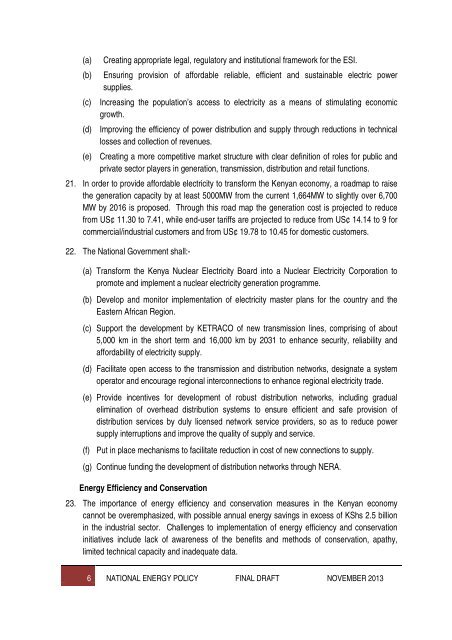National Energy Policy - Final Draft - 14 Nov 2013
National Energy Policy - Final Draft - 14 Nov 2013
National Energy Policy - Final Draft - 14 Nov 2013
Create successful ePaper yourself
Turn your PDF publications into a flip-book with our unique Google optimized e-Paper software.
(a)(b)Creating appropriate legal, regulatory and institutional framework for the ESI.Ensuring provision of affordable reliable, efficient and sustainable electric powersupplies.(c) Increasing the population’s access to electricity as a means of stimulating economicgrowth.(d) Improving the efficiency of power distribution and supply through reductions in technicallosses and collection of revenues.(e) Creating a more competitive market structure with clear definition of roles for public andprivate sector players in generation, transmission, distribution and retail functions.21. In order to provide affordable electricity to transform the Kenyan economy, a roadmap to raisethe generation capacity by at least 5000MW from the current 1,664MW to slightly over 6,700MW by 2016 is proposed. Through this road map the generation cost is projected to reducefrom US¢ 11.30 to 7.41, while end-user tariffs are projected to reduce from US¢ <strong>14</strong>.<strong>14</strong> to 9 forcommercial/industrial customers and from US¢ 19.78 to 10.45 for domestic customers.22. The <strong>National</strong> Government shall:-(a) Transform the Kenya Nuclear Electricity Board into a Nuclear Electricity Corporation topromote and implement a nuclear electricity generation programme.(b) Develop and monitor implementation of electricity master plans for the country and theEastern African Region.(c) Support the development by KETRACO of new transmission lines, comprising of about5,000 km in the short term and 16,000 km by 2031 to enhance security, reliability andaffordability of electricity supply.(d) Facilitate open access to the transmission and distribution networks, designate a systemoperator and encourage regional interconnections to enhance regional electricity trade.(e) Provide incentives for development of robust distribution networks, including gradualelimination of overhead distribution systems to ensure efficient and safe provision ofdistribution services by duly licensed network service providers, so as to reduce powersupply interruptions and improve the quality of supply and service.(f) Put in place mechanisms to facilitate reduction in cost of new connections to supply.(g) Continue funding the development of distribution networks through NERA.<strong>Energy</strong> Efficiency and Conservation23. The importance of energy efficiency and conservation measures in the Kenyan economycannot be overemphasized, with possible annual energy savings in excess of KShs 2.5 billionin the industrial sector. Challenges to implementation of energy efficiency and conservationinitiatives include lack of awareness of the benefits and methods of conservation, apathy,limited technical capacity and inadequate data.6 NATIONAL ENERGY POLICY FINAL DRAFT NOVEMBER <strong>2013</strong>


